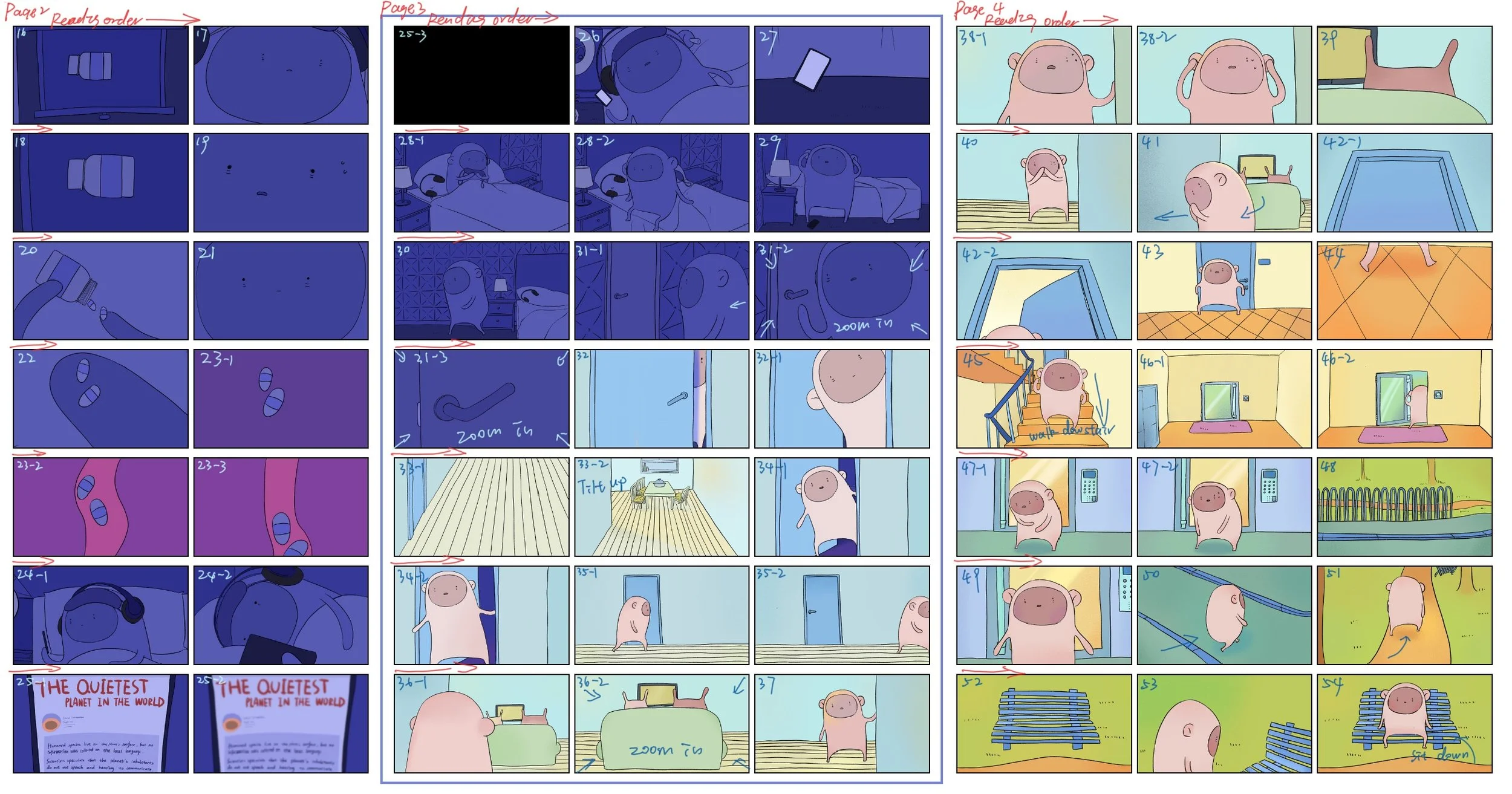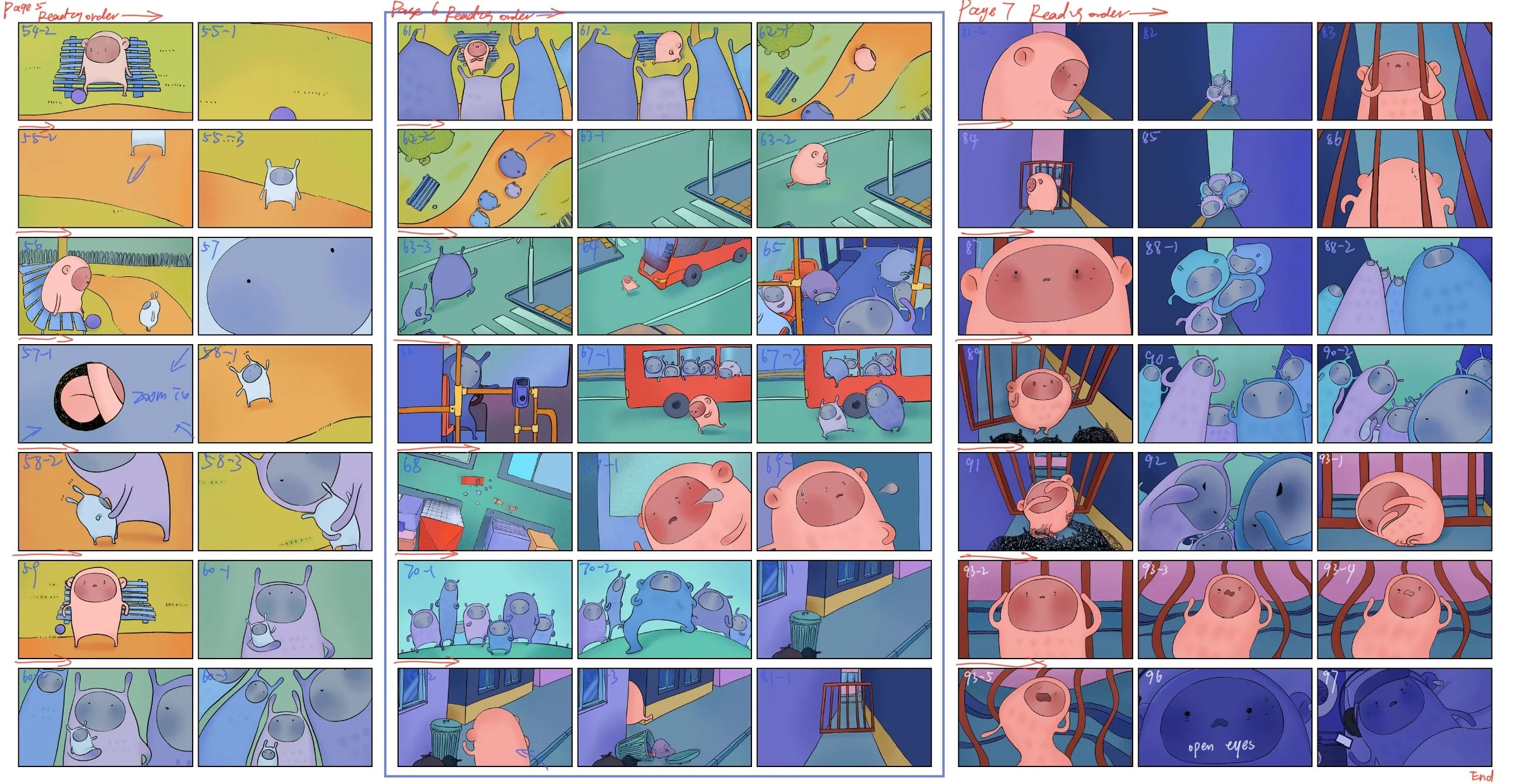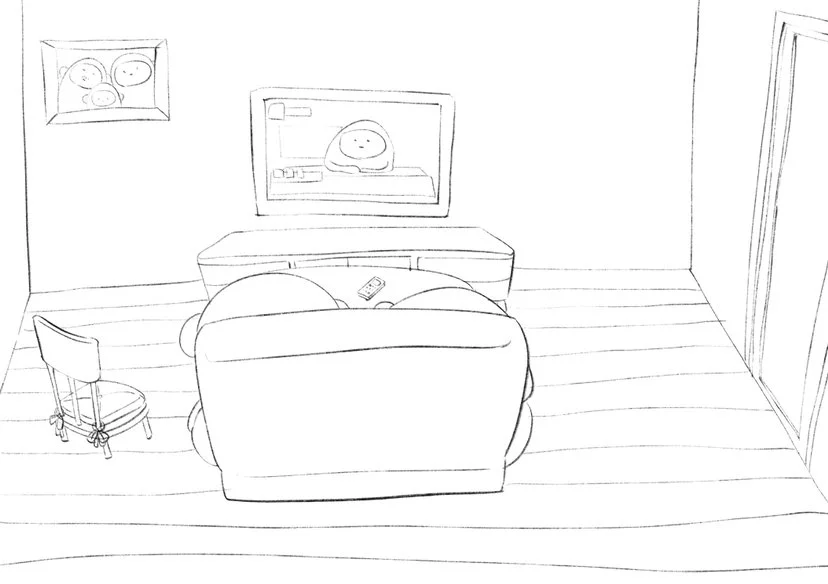(H)ear
(H)ear is a visual development project that includes character design, environment concepts, and a narrative storyboard.
Set in a world where silence takes on an unsettling new meaning, the story follows Eartha, a person hypersensitive to sound, who wakes up one day to find the world eerily quiet. At first, the silence brings relief—but soon, strange details begin to emerge, hinting that something about this new reality is not what it seems.
The room is dimly lit, its walls covered in soundproofing foam.
Eartha sits on the bed, rips off a sleep mask, and tosses it into the trash. From the nightstand, they take out a fresh mask and a pair of earplugs, switch off the light, and lie down to sleep.
As soon as Eartha closes their eyes, the noise begins to grow—amplified and unbearable. The creaking floor above, the groaning of the air ducts, the neighbors arguing through the walls.
Eartha sits up, frustrated. Sleep has become impossible. It’s been this way for a long time.
They grab a pair of earmuffs from the nightstand, put them on, and try again. But the noise only escalates. Eartha bolts upright, clutching their head, overwhelmed.
Voices rush in, from memory or imagination—it’s hard to tell.
“Why don’t you talk to anyone?”
“Why don’t you answer?”
“Why are you always wearing headphones?”
These echoes from childhood and beyond crash down. Eartha grips the blanket tightly.
Eartha glanced at the nightstand and noticed a bottle of sleeping pills. With a sigh, they picked it up, poured two pills into their hand, stared at them in hesitation—then swallowed them with quiet resolve.
But even drowsiness couldn’t override the mental noise. Eartha grabbed their phone and started scrolling. A headline flashed across the screen:
“The Quietest Planet in the Universe—Where People Have No Mouths or Ears.”
Curious, Eartha tapped the article. It read:
“On Quiet Star, residents communicate through soft, antenna-like tentacles.”
As the words blurred, the sleeping pills began to take effect. Eartha’s eyes slowly closed.
Darkness. The noise returned.
Eartha suddenly sat up—eyes open. But this time, everything was silent. Completely silent.
Cautiously, they removed the earmuffs. Then the earplugs. Still, no sound. Confused, Eartha touched their ears—checking, almost not believing.
They got out of bed slowly and walked to the door. Light from the hallway poured in.
"Did I sleep that long? Is it already morning?"
Eartha walked through the house, calling softly:
“Dad? Mom?”
No answer.
In the living room, their parents were sitting silently on the couch, backs turned. Neither moved. The silence was suffocating. Eartha froze. Something was wrong.
Then—they saw it. Both parents had strange, soft tentacles where their ears should be.
Startled, Eartha reached up and touched their own ears—relieved to feel nothing abnormal. With rising panic, they stepped backward, opened the front door, and ran outside.
The streets were still. Empty. Possibly because it was early, but eerily quiet.
Eartha wandered into a nearby park and sat on a bench, soaking in the silence. For the first time, the quiet felt… peaceful.
Suddenly, a ball rolled to Eartha’s feet, followed by a small child with tentacles. The child stopped in front of Eartha, staring at them curiously—as if looking at a strange creature.
Then the child tilted its head to the side, and its tentacles began to glow red, pointing directly at Eartha. Confused, Eartha turned to follow the child's gaze—only to see the child’s parent rushing over. The parent scooped the child up and backed away several meters, clearly alarmed.
At the same time, more creatures with tentacles began to gather around.
Fear surged through Eartha. They stood up, backing away slowly, then turned and ran in a panic. But the creatures followed close behind.
Eartha bolted out of the park and onto the street, causing chaos in the road. A red bus screeched to a halt, narrowly avoiding her. Passengers were thrown forward from the sudden stop.
When the driver and passengers saw Eartha’s “deformed” human ears, they got off the bus and joined the chase. Now, people on the street were running after her, trying to catch her.
Cornered at the end of an alley, Eartha was quickly surrounded. The crowd grabbed at her, pulling at her ears, trying to rip them off. Eartha screamed, covering her ears in terror.
Suddenly—Eartha opened their eyes.
It was just a dream.
Eartha is deeply introverted and rarely initiates communication with others. Highly sensitive to sound, Eartha often struggles to sleep due to constant background noise.
Dark circles under their eyes hint at long-term exhaustion, and falling asleep has become a nightly battle involving various coping methods.
Eartha’s greatest wish is simple yet impossible: to live in a world without sound.
The Silentkind are a serene and enigmatic species inhabiting the Quiet Star. Their most distinctive feature is the absence of ears, replaced by delicate, translucent feelers that gracefully extend from the sides of their heads. These feelers serve as their primary means of communication, allowing them to send and receive signals in a silent, harmonious manner.
Their skin tones predominantly consist of soft, pale blues, with subtle variations in hue that reflect their individual identities. This monochromatic palette reinforces the tranquil and otherworldly atmosphere of their environment.
Eartha's room is a carefully arranged space designed to minimize noise and provide her with a safe haven from the hustle and bustle of the outside world. The walls are covered with soundproofing pads, absorbing ambient noise and reflecting Eartha's deep-seated aversion to sound.
In my initial design, the room was cluttered with various personal items, symbolizing Eartha's reluctance to contact with the outside world and her tendency to self-isolate. However, I realized that this chaos would lead to unexpected noises - objects falling, things being knocked over - disrupting her pursuit of silence. Therefore, Eartha's space should be a clean and uncluttered environment, where every object has its place and potential sources of noise are minimized.









